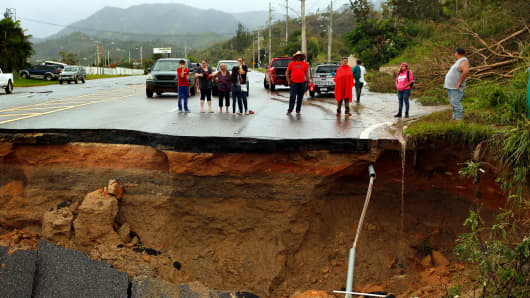Congress just approved $36.5 billion in emergency "off-budget" appropriations in response to recent hurricanes and wildfires. Quickly providing this emergency funding and relief is the right thing to do, but Congress must come to terms with the need for better planning and funding before the next major disaster strikes.
Congress made a modest attempt to account for disaster funding in the 2011 Budget Control Act, establishing an on-budget "disaster relief allowable adjustment" for the Federal Emergency Management Agency (FEMA) through annual appropriations. This adjustment is based on the average federal disaster expenses from the previous 10 years and allows for an increase above the budget caps of $7.5 billion and $9.5 billion each year through 2021. In some years, this may be sufficient, but in 2017, this is just a drop in the bucket.
Continuing this pattern of ad hoc funding represents trillions of dollars in unfunded liabilities over the next 75 years, on par with looming Social Security shortfalls. Instead, appropriations should be made in accordance with a legitimate estimate of average annual relief costs, with funds rolling forward from year to year so adequate funding is available in extremely costly years.
But implementing more stable funding without undertaking fundamental reforms is fiscally reckless and politically untenable. Congress must reevaluate the Stafford Act, the 1988 law which guides federal emergency response. The Act, in many cases, imposes limitations on rebuilding infrastructure, often resulting in assets being rebuilt as they were before the disaster.
The often-quoted definition of insanity, 'repeating behavior and expecting different results', comes to mind. It is critical that all infrastructure be rebuilt in accordance with the latest advances in resiliency, efficiency and functionality. Commonsense reforms to allow appropriate reconstruction upgrades are long overdue. Congress should also pursue innovative ideas that encourage private sector investment in resilience and relief efforts. Pending legislation enabling businesses to invest tax-free disaster in recovery would be a step in the right direction.
The perpetually underwater National Flood Insurance Program, still projected to be billions in debt even after the latest bailout, is in desperate need of reform. Most Americans lack any flood insurance, with rates of the uninsured routinely eclipsing 80 percent in flood-prone communities. But while flood insurance will cover damage costs flood after predictable flood, there is no mechanism to help people who want to move to places that are safer, drier, and far less costly.
Fortunately, we have demonstrated the capacity to learn from previous disasters. Congress passed important improvements in disaster response and preparedness in the Sandy Recovery Improvement Act of 2013, the first major overhaul since the Stafford Act. While some reforms have been implemented, recommendations by FEMA on improving resiliency of states, local, and tribal communities to lower future response and recovery costs require new legislation, and have not been enacted into law.
Working together, Congress, the administration, states, and the private sector can develop safer and far more cost-effective approaches that provide the necessary relief to impacted citizens, while making our underlying infrastructure more resilient and our communities better prepared for what's to come.
In a little-remembered story by F. Scott Fitzgerald called "Family in the Wind," a second tornado in two days rips through a small Alabama town, causing the story's hero, a local doctor, to remark: "This is worse than a calamity; it's getting to be a nuisance." Extreme weather and fire-related disasters are becoming more commonplace, more deadly, and more costly. Our elected leaders, at all levels, owe it to current and future victims and survivors to develop policies and practices to deliver more effective, and less-costly, disaster relief to those who desperately need it.
Commentary by Trent Lott, a former Senate Majority Leader and senior fellow at the Bipartisan Policy Center and Jason Grumet is president of the Bipartisan Policy Center.
For more insight from CNBC contributors, follow
@CNBCopinion
on Twitter.


